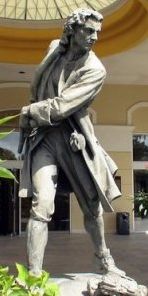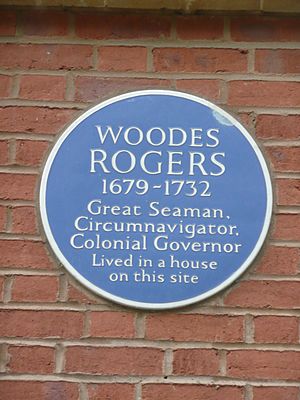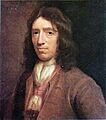Woodes Rogers facts for kids
Quick facts for kids
Woodes Rogers
|
|
|---|---|
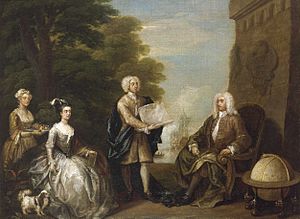
Rogers (right) receives a map of New Providence Island from his son, in a painting by William Hogarth (1729)
|
|
| Royal Governor of the Bahama Islands | |
| In office 6 January 1718 – June 1721 |
|
| Appointed by | George I |
| Preceded by | New creation |
| Succeeded by | George Phenney |
| In office 22 October 1728 – 15 July 1732 |
|
| Appointed by | George II |
| Preceded by | George Phenney |
| Succeeded by | Richard Thompson (acting governor) |
| Personal details | |
| Born | c. 1679 (presumed) Dorset, England |
| Died | July 15, 1732 (aged approximately 53) Nassau, Bahamas |
| Resting place | Nassau, Bahamas |
| Children | 3 |
Woodes Rogers (around 1679 – 15 July 1732) was an English sea captain and privateer. A privateer was like a legal pirate, allowed by their government to attack enemy ships during wartime. Rogers later became the first Royal Governor of the Bahamas in 1718. He is famous for rescuing Alexander Selkirk, a sailor who was stranded on an island. Selkirk's story is thought to have inspired Daniel Defoe's famous book, Robinson Crusoe.
Rogers came from a family of sailors. He grew up in Poole and Bristol, England. In 1707, he led an important privateering trip around the world. His ships, Duke and Duchess, captured several enemy ships. During this journey, they found Selkirk on Juan Fernández Island in 1709. When Rogers returned to England in 1711, he had sailed all the way around the globe. His investors made a lot of money, and he became a national hero.
However, Rogers was also badly hurt in battles, and his brother was killed. He faced financial problems and even went to jail for debt later in life. He wrote a popular book about his adventures called A Cruising Voyage Round the World.
Rogers was appointed Governor of the Bahamas twice. He successfully protected the colony from Spanish attacks and helped clear the area of pirates. He died in Nassau when he was about 53 years old.
Contents
Early Life and Family
Woodes Rogers was the oldest son of Woods Rogers, a successful merchant captain. Young Woodes spent some of his childhood in Poole, England. His father owned parts of many ships and was often away at sea. Around 1690, his family moved to Bristol.
In 1697, Woodes Rogers began training to become a sailor. He was 18, which was a bit old to start such training. This might have helped him become a voting citizen of Bristol. He likely gained his sailing experience on ships that went to Newfoundland.
Rogers finished his training in 1704. The next year, he married Sarah Whetstone, whose father was a well-known admiral. In 1706, Rogers' father died at sea, leaving his ships and business to Woodes. Between 1706 and 1708, Woodes and Sarah Rogers had three children.
Around the World: A Privateering Journey
Getting Ready and Setting Sail

The War of the Spanish Succession began in 1702. During this war, England fought against France and Spain. Many ships from Bristol were given special permission, called "letters of marque," to attack enemy ships. Rogers had invested in some of these ships.
In late 1707, William Dampier, a famous navigator, suggested a privateering trip against the Spanish. Rogers agreed to lead this expedition. Many people in Bristol helped pay for the trip. Rogers commanded two ships, the Duke and the Duchess, and was captain of the Duke. Dampier joined as the sailing master, helping to guide the ships. They left Bristol on 1 August 1708.
The journey had some challenges. Forty crew members left or were fired in Bristol. Rogers had to find new sailors in Ireland. Some of the crew tried to rebel when Rogers stopped them from taking goods from a neutral ship. He punished the leaders, but the trip continued. The ships had a tough time sailing around the tip of South America, facing very cold weather.
Finding Selkirk and Raiding Spanish Towns
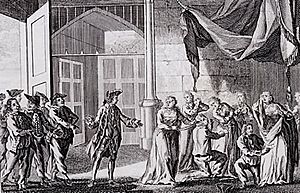
Rogers made sure his ships had limes to prevent scurvy, a disease caused by lack of vitamin C. After reaching the Pacific Ocean, they ran out of limes, and some men got sick. Dampier guided them to Juan Fernández Island to get fresh food.
On 1 February 1709, they saw a fire on the island. The next morning, a group went ashore and found a Scottish sailor named Alexander Selkirk. He had been stranded there for four years! Rogers described Selkirk as "wild-looking" and wearing "goatskins." Selkirk had his clothes, a gun, some tools, a Bible, and other books. Selkirk joined Rogers' crew and later even commanded one of the captured ships. His story later inspired Daniel Defoe's Robinson Crusoe.
After leaving the island, the expedition captured several small ships. They also attacked the town of Guayaquil in what is now Ecuador. Rogers managed to get some money from the town, but some crew members were unhappy and even dug up graves looking for valuables. This caused sickness among the crew.
The expedition later lost contact with one of their captured ships, commanded by Simon Hatley. Hatley and his men were captured by the Spanish. Hatley's later adventure, where he shot an albatross during a storm, became famous in a poem by Samuel Taylor Coleridge called "The Rime of the Ancient Mariner".
The crew became restless, but their spirits lifted when they captured a rich Spanish ship, the Nuestra Señora de la Encarnación y Desengaño, off the coast of Mexico. Rogers was wounded in the face during this battle. They failed to capture another well-armed Spanish ship. The privateers, with their captured ships, then sailed across the Pacific. They stopped at Guam, which was controlled by Spain but welcomed them.
The Journey Home
The ships then went to Batavia (now in Indonesia), a Dutch port. There, Rogers had surgery to remove a musket ball from his mouth. They also sold one of the less seaworthy Spanish ships.
On 14 October 1711, the ships finally arrived back in England. Rogers had successfully sailed around the world. He was the first Englishman to do this with his original ships and most of his crew still alive. The investors in the trip made about double their money. Rogers himself earned some money, but it was used to pay off debts his family had made while he was away. He was injured, and his brother was killed during the voyage. Despite this, Rogers became a national hero.
After his journey, Rogers wrote a book about it called A Cruising Voyage Round the World. Many readers were fascinated by his story, especially the rescue of Selkirk. This book helped inspire Daniel Defoe to write Robinson Crusoe. Rogers' book also aimed to help other British sailors and possible colonists by describing the places he visited in detail.
Governor of the Bahamas
Financial Troubles and a New Plan
When Rogers returned to England, he faced financial problems. He had to sell his home to support his family. Over 200 of his crew members sued him, saying they hadn't received their fair share of the profits. Rogers went bankrupt and was even put in jail for debt.
To solve his money problems, Rogers decided to lead another expedition, this time against pirates. He first looked at Madagascar, but then turned his attention to the West Indies. He made a deal with King George I to manage the Bahamas, which were full of pirates.
At this time, the Bahamas were known as a "nest of infamous rascals" with no real government. The King officially appointed Rogers as "Captain General and Governor in Chief" on 6 January 1718. Before leaving, Rogers spent months preparing. He gathered seven ships, 100 soldiers, 130 colonists, and supplies. The expedition, along with three Royal Navy ships, sailed from England on 22 April 1718.
Rogers' First Term as Governor
The expedition arrived in Nassau on 24 July 1718. They surprised and trapped a ship belonging to the pirate Charles Vane. Vane managed to escape, but Nassau and New Providence Island were now in Rogers' hands.
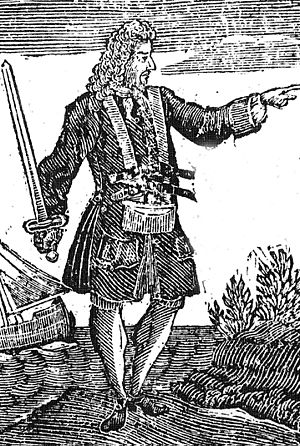
The island's population was mostly former pirates and people who had escaped from Spanish colonies. Rogers set up a government and offered the King's Pardon to pirates who agreed to stop their illegal activities. He also began rebuilding the island's defenses, which were in bad shape.
Rogers faced many challenges. A disease killed almost a hundred of his expedition members. Two of the navy ships left, and ships sent to talk with the Spanish governor in Havana had their crews rebel and become pirates. Work on the fortifications was slow because the locals didn't want to work.
In September 1718, Rogers learned that Charles Vane was nearby. Some pardoned pirates left to join Vane. Rogers declared martial law, meaning everyone had to help rebuild the forts. He sent former pirate captains, like Benjamin Hornigold, to find Vane. They didn't capture Vane, but they did bring back other pirate prisoners. On 9 December 1718, Rogers held trials for these pirates. Nine were found guilty, and eight were executed. This action helped to control the population.
In March 1719, Rogers learned that Spain and Britain were at war again. He worked even harder to fix the forts, buying supplies on credit. In May, a Spanish fleet planned to attack Nassau, but they changed course. This gave Rogers more time. In February 1720, the Spanish finally arrived in Nassau. However, alert guards, the presence of British warships, and 500 ready militia (many of them former pirates) caused the Spanish to leave.
By 1720, the external threats to Rogers' rule ended. Spain and Britain were at peace, and Vane was captured and later executed in Jamaica. But Rogers' problems continued. He had spent too much money on defenses and received no help from Britain. Merchants refused him more credit. His health suffered, and he went to Charleston, South Carolina, to recover. He was even wounded in a duel there. Rogers felt unsupported by London and sailed back to Britain in March 1721. He found that a new governor had been appointed, and his company had been shut down. He was personally responsible for the debts he made in Nassau and was put in debtor's prison.
Later Life and Second Term
Rogers was released from prison when his creditors felt sorry for him and forgave his debts. Around 1722, he helped a writer who was creating a history of piracy. The book, A General History of the Robberies and Murders of the Most Notorious Pyrates, became very popular and made Rogers a national hero again.
With public attention back on him, Rogers successfully asked King George I for financial help in 1726. He received a pension, and King George II reappointed him as governor on 22 October 1728.
During his second term, the Bahamas did not face outside threats. However, Rogers had trouble with the local assembly, which was a group of elected representatives. He wanted to create a local tax to improve defenses, but the assembly disagreed. Rogers responded by dissolving the assembly. This fight exhausted Rogers, and he went to Charleston again in 1731 to recover his health. He returned in July 1731 but never fully got better. Woodes Rogers died in Nassau on 15 July 1732, at about 53 years old.
A street in Nassau is named after him. The motto of the Bahamas until 1973 was "Piracy expelled, commerce restored," which reflects Rogers' work.
Images for kids
See also
 In Spanish: Woodes Rogers para niños
In Spanish: Woodes Rogers para niños


